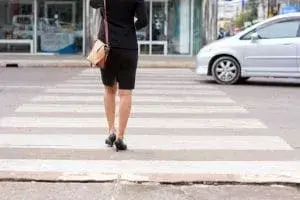Pedestrian crosswalks are critical areas designed to ensure the safety of those walking alongside vehicular traffic. However, accidents in these zones can lead to severe consequences for both drivers and pedestrians. Understanding who is at fault and the potential legal ramifications is essential for all parties involved.
Who is Typically at Fault in Crosswalk Accidents?
In most cases, when a car accident occurs in a pedestrian crosswalk, the driver is deemed liable. This liability stems from the driver’s responsibility to yield to pedestrians in designated crossing areas. Failing to do so can result in significant legal repercussions.
Legal Consequences for the Driver
Depending on the severity of the accident, the driver may face:
- Criminal Charges: In cases of negligence or reckless driving, drivers might be charged with misdemeanors or even felonies.
- Civil Charges: Drivers may also be held financially responsible for medical expenses, property damage, and other related costs.
It’s crucial for drivers to recognize the gravity of such incidents and the potential for both criminal and civil liabilities.
Responsibility for Damages and Injuries
Drivers involved in crosswalk accidents must be prepared to accept responsibility for any damages or injuries resulting from their negligence. This includes:
- Medical Bills: Covering the costs of treating injured pedestrians.
- Property Damage: Repairing or replacing damaged vehicles or personal property.
- Legal Fees: Managing the costs associated with defending against charges or lawsuits.
Preventing Crosswalk Accidents
Safety measures and awareness can significantly reduce the occurrence of these accidents. Drivers should always:
- Obey Traffic Signals: Stop at red lights and yield to pedestrians at crosswalks.
- Stay Alert: Avoid distractions such as texting or using a phone while driving.
- Maintain Speed: Adhere to speed limits, especially in areas with high pedestrian traffic.
Frequently Asked Questions (FAQ)
Q: What should a pedestrian do if they are hit in a crosswalk?
A: Immediately seek medical attention, document the scene, gather witness information, and contact law enforcement. It’s also advisable to consult with a personal injury attorney to understand your rights.
Q: Can a driver be charged if the pedestrian was jaywalking?
A: While drivers generally have the right of way in crosswalks, if a pedestrian is jaywalking or crossing unlawfully, it may affect the liability determination. However, drivers are still expected to exercise caution and avoid collisions.
Q: What evidence is important in crosswalk accident cases?
A: Key evidence includes traffic camera footage, witness statements, police reports, and any available surveillance from nearby businesses or homes.
Understanding Right of Way: Essential Guidelines for Cars and Pedestrians
Ensuring safety on the roads is a shared responsibility between drivers and pedestrians. Understanding the right of way rules is crucial for preventing accidents and fostering a harmonious traffic environment. This guide outlines the fundamental principles governing right of way for both cars and pedestrians, providing you with the knowledge to navigate crosswalks, intersections, and designated walking areas safely.
Pedestrian Responsibilities
Pedestrians play a vital role in road safety. To ensure their safety, pedestrians must adhere to the following guidelines:
- Obey Traffic Signals and Signs: Always follow the pedestrian signals at intersections. Wait for the walk sign before crossing and refrain from crossing against the signal.
- Use Sidewalks When Available: Sidewalks are designed to keep pedestrians safe from vehicular traffic. Always use sidewalks instead of walking on the road.
- Cross at Designated Areas: Only cross streets at marked crosswalks or intersections. These areas are specifically designed for safe pedestrian crossing.
Driver Responsibilities
Drivers must remain vigilant and respectful of pedestrians to prevent accidents. Key responsibilities include:
Stay Alert for Pedestrians: Always be aware of your surroundings, especially in areas with high pedestrian traffic. Avoid distractions such as texting or using your phone while driving.
Yield at Crosswalks and Intersections: Vehicles must always yield to pedestrians at crosswalks, intersections, and other designated walking areas. This means slowing down and preparing to stop when pedestrians are present.
Maintain a Safe Distance: When a pedestrian is crossing the roadway, drivers should stop at least 20 feet away to ensure ample space and reaction time.
The Definition Of A Pedestrian
A Pedestrian is defined as a person traveling on foot, especially in a city or built-up area. Pedestrians are also known as walkers and can be found walking on sidewalks, in parks, or along city streets.
What Is Considered A Crosswalk?
A crosswalk is an area designated for pedestrians to cross a road safely. This area is usually marked by white or yellow lines and is sometimes accompanied by a traffic signal.
Pedestrians Must Stay Out Of Bike Lanes
Pedestrians should never enter bike lanes while they are in use by cyclists. Bike lanes are a dedicated area of roadway that is specifically reserved and designated for cyclists. Pedestrians should use the sidewalks and pedestrian paths that are meant for their use and should stay out of the bike lanes. Entering a bike lane is not only dangerous for the cyclist, as it can cause a potential bike crash, but it also puts the pedestrian in danger too.

Walking On A Crosswalk Gives Pedestrians The Right Of Way
Yes, it is true that walking on a crosswalk gives pedestrians the right of way. Pedestrians must always cross the street at a designated crosswalk whenever possible, and when they are crossing, motorists must yield to them and give them the right of way.
Pedestrian Right of Way for an Intersection
At an intersection, pedestrians always have the right of way, regardless of other traffic present. All drivers must yield to pedestrians in any intersection, even when no crosswalks are present.
Pedestrian Right of Way for Roundabouts
In the United States, pedestrians generally have the right of way at roundabouts. Drivers must always yield to pedestrians and bicyclists at a roundabout. In most cases, drivers must also give the right of way to pedestrians and bicyclists at other points within the roundabout. However, in some states, such as Massachusetts and New York, drivers must yield to pedestrians and bicyclists before entering the roundabout.
Who has the right away on a Mountain Road?
The vehicle going uphill typically has the right of way on a mountain road. The vehicle going downhill should yield and allow the vehicle going uphill to pass.
Pedestrian Crosswalks Laws in California:
1. Pedestrians have the right of way at any marked or unmarked crosswalk, regardless of whether the crossing is at a street corner.
2. Drivers must stop for pedestrians who have started crossing the street at a crosswalk.
3. Drivers must yield to pedestrians who are crossing within any marked or unmarked crosswalk.
4. Vehicles must yield to pedestrians who are crossing at a crosswalk on the same side of the roadway or are approaching from the opposite side of the roadway and within one lane of the vehicle.
5. Vehicles must stop and remain stopped until the pedestrian has completely crossed the roadway.
Car Accident Laws in California:
1. Drivers must exercise reasonable care when operating a vehicle and must not drive in a reckless or negligent manner.
2. Drivers must obey all traffic laws and obey the speed limit.
3. Drivers must yield the right of way to pedestrians, bicyclists, and other vehicles according to the particular circumstances.
4. Drivers must maintain a safe following distance, stay in lanes, and use signals when turning.
5. Drivers must immediately stop at the scene of an accident and provide identifying information to involved parties or police.
If you have any legal questions about an accident, consult a car accident attorney.
What Happens if you are Jaywalking and Got Hit by a Car?

If you are jaywalking and are hit by a car, you could be held liable for any damages the driver suffered due to the collision. Being in California and depending on the severity of the crash, either party can be charged with negligence if it is determined that one of the parties is at fault. Additionally, either party could be held responsible for any medical bills, lost wages, and other expenses incurred.
California Pedestrian Safety Tips:
1. Always cross at a crosswalk or intersection when possible.
2. Make sure to look both ways before crossing the street.
3. Obey traffic signals and signs.
4. Wear bright, reflective clothing when walking at night.
5. Walk facing traffic to make yourself more visible.
6. Don’t be distracted by phones or other devices when walking.
7. Don’t use headphones when crossing the street.
8. Pay attention to your surroundings and watch for oncoming vehicles.
9. Avoid walking in the dark or in isolated areas.
10. Carry a flashlight when walking in the dark.
If a Car Collides with a Pedestrian, what should you do?

If you witness a pedestrian being hit by a car, it is important to take immediate action to help the pedestrian and call for emergency medical assistance. Here are the steps you can take:
Check for injuries: First, assess the pedestrian’s condition and check for any obvious injuries. If the pedestrian is unconscious or not breathing, call for emergency medical assistance immediately and begin CPR if you are experienced and trained.
Dial 911, and call for help; provide the operator with the location of the accident, the number of people involved, and any injuries that you can observe.
Provide first aid: If the pedestrian is conscious and able to speak, try to keep them calm and still. If they are bleeding, make sure you apply pressure directly to the wound to help try and stop the bleeding. If the pedestrian is in shock, try to keep them warm and comfortable.
Secure the scene: If you are able to do so safely, try to protect the area where the accident occurred by placing warning signs or cones around the area. This will help to prevent other accidents from occurring.
Gather information: If you are able to do so safely, try to gather as much information as possible about the accident, including the location, time of day, weather conditions, and any other relevant details. This information may be useful to the authorities and the pedestrian’s insurance company.
It is important to remember to stay calm and try to help the pedestrian as much as possible. Do not move the pedestrian unless they are in danger or you are trained to do so.
Can a Car Pass in Front of a Pedestrian in California?
In California, it is generally illegal for a driver to pass a pedestrian who is in the process of crossing a roadway within a marked or unmarked crosswalk. This means that a driver must wait for the pedestrian to finish crossing the road before proceeding.
This law has a few exceptions. One example is when a pedestrian is crossing the road at an unmarked or marked crosswalk and at a location other than an intersection, and there is a traffic signal or other traffic control device present, the driver must obey the signal or device.
In addition, if a pedestrian is crossing a roadway within an unmarked or marked crosswalk at a place other than an intersection and there is no traffic signal or other traffic control device present, the driver must yield the right-of-way to the pedestrian and may not pass the pedestrian until it is safe to do so.
Drivers need to be aware of pedestrians and to always yield to pedestrians who are in crosswalks or attempting to cross the road. Drivers should also be mindful of their speed and keep an eye out for pedestrians, particularly in areas where pedestrians are more likely to be present, such as near schools, parks, and residential areas.
How long does a Pedestrian Accident stay on your Driving Record in California?
In California, most traffic violations, including pedestrian accidents, remain on a driver’s record for a period of three years. This means that the pedestrian accident will be visible on your driving record for three years from the date of the accident.
However, the length of time that an accident remains on your driving record can vary depending on the specific circumstances of the accident and any resulting convictions or penalties. One example is if you are convicted of a felony as a result of a pedestrian accident, such as reckless driving or hit-and-run, the conviction could remain on your record for a longer period of time.
***Disclaimer: This webpage has been crafted by Heidari Law Group solely for educational purposes. The content of this article aims to offer a broad comprehension of the law and does not constitute specific legal advice. By accessing this site and perusing its contents, no attorney-client relationship is established between you and any member of Heidari Law. Additionally, it’s important to note that the legal landscape is subject to continuous change, rendering some of the information provided herein potentially outdated or no longer applicable.



